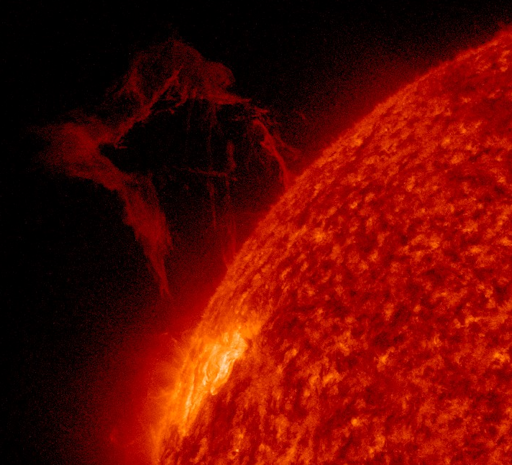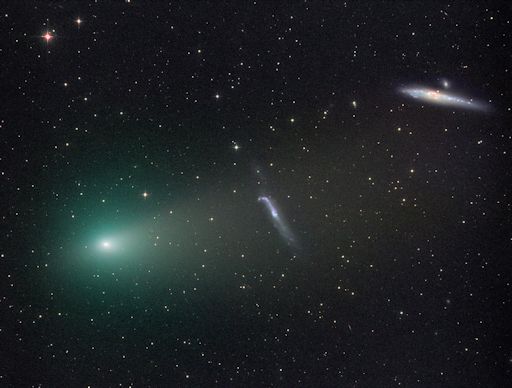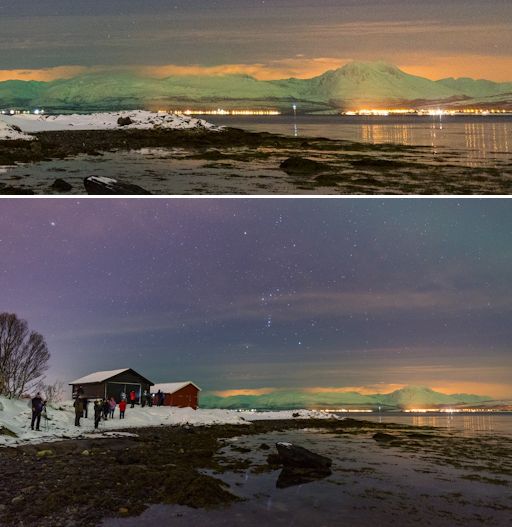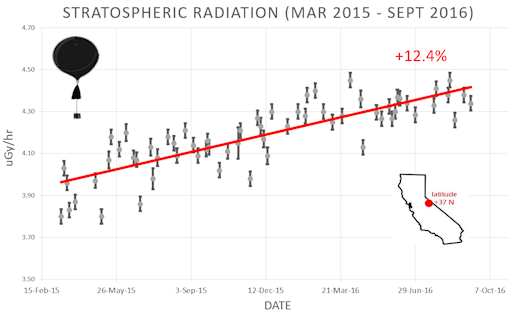Directly under the Arctic Circle! Marianne's Arctic Xpress in Tromsø offers fjord, whale and wildlife tours by day, aurora tours by night. Book Now for out of this world day and night adventures. | | | INCREASING CHANCE OF STORMS: According to NOAA forecasters, the chance of polar geomagnetic storms will increase from 30% today to 40% on Feb. 22nd, then 60% on Feb. 23rd. This comes as Earth approaches a fast-moving rivulet in a stream of solar wind already surrounding our planet. Arctic sky watchers should remain alert for auroras. Free: Aurora Alerts SOLAR TORNADO OVER-ROTATES, EXPLODES: Yesterday, an explosion on the sun's eastern limb hurled a twisted plume of debris more than 250,000 km above the solar surface. NASA's orbiting Solar Dynamics Observatory recorded the blast: 
An 8-hr movie recorded by extreme ultraviolet telescopes onboard the spacecraft shows what happened: A tornado of magnetized plasma became unstable when the twister twisted a bit too much. Magnetic fields crissed, crossed, and exploded in a process known as "magnetic re-connection." The flying debris will not hit our planet; the blast was too far off the sun-Earth line. Realtime Space Weather Photo Gallery AN UNUSUAL FLYBY: On Feb. 11th, green Comet 45P/Honda-Mrkos-Pajdusakova flew past our planet in one of the closest Earth-comet encounters of the Space Age. It was a disappointment, though, as the fizzling comet was too dim to see with the unaided eye. A week later, the comet executed a much more satisfying flyby--of two distant galaxies. Michael Jäger of Stixendorf, Austria, photographed the event on Feb. 18th: 
Located 25 million light years away, these two galaxies have been nicknamed by astronomers "The Whale and the Hockey Stick." The strange shape of the Hockey Stick is thought to result from a long-ago encounter with the Whale. No one can say exactly what happened. Probably the Whale's gravity probably pulled a plume of star forming gas from the body of the other galaxy, transforming the starry disk into something akin to a bent stick. The official names of these star systems are NGC4656 and NGC4631. More photos of this unusual flyby may be found in the Realtime Comet Photo Gallery. Enjoy! Realtime Comet Photo Gallery GREEN MOUNTAINS IN NORWAY: During an outburst of Northern Lights, most people stare at the sky. Sometimes, however, it pays to look at the ground. "On Feb. 18th, the mountains around us turned green," reports Didier Van Hellemojt from Tromsø, Norway, more than 200 miles north of the Arctic Circle. "The snowy slopes reflected the color of the green auroras overhead." 
Green terrain could become a common sight in the nights ahead. Earth is inside a wide stream of solar wind that will influence our planet, off and on, for the rest of the month. Activity could reach a crescendo at the end of February when, according to NOAA analysts, G2-class geomagnetic storms could erupt around the Arctic Circle. Stay tuned for updates. Free: Aurora Alerts
Realtime Aurora Photo Gallery
Every night, a network of NASA all-sky cameras scans the skies above the United States for meteoritic fireballs. Automated software maintained by NASA's Meteoroid Environment Office calculates their orbits, velocity, penetration depth in Earth's atmosphere and many other characteristics. Daily results are presented here on Spaceweather.com. On Feb. 21, 2017, the network reported 11 fireballs.
(11 sporadics)  In this diagram of the inner solar system, all of the fireball orbits intersect at a single point--Earth. The orbits are color-coded by velocity, from slow (red) to fast (blue). [Larger image] [movies] Potentially Hazardous Asteroids ( PHAs) are space rocks larger than approximately 100m that can come closer to Earth than 0.05 AU. None of the known PHAs is on a collision course with our planet, although astronomers are finding new ones all the time. On February 21, 2017 there were 1775 potentially hazardous asteroids. Notes: LD means "Lunar Distance." 1 LD = 384,401 km, the distance between Earth and the Moon. 1 LD also equals 0.00256 AU. MAG is the visual magnitude of the asteroid on the date of closest approach. | | Cosmic Rays in the Atmosphere |
Readers, thank you for your patience while we continue to develop this new section of Spaceweather.com. We've been working to streamline our data reduction, allowing us to post results from balloon flights much more rapidly, and we have developed a new data product, shown here: 
This plot displays radiation measurements not only in the stratosphere, but also at aviation altitudes. Dose rates are expessed as multiples of sea level. For instance, we see that boarding a plane that flies at 25,000 feet exposes passengers to dose rates ~10x higher than sea level. At 40,000 feet, the multiplier is closer to 50x. These measurements are made by our usual cosmic ray payload as it passes through aviation altitudes en route to the stratosphere over California. What is this all about? Approximately once a week, Spaceweather.com and the students of Earth to Sky Calculus fly space weather balloons to the stratosphere over California. These balloons are equipped with radiation sensors that detect cosmic rays, a surprisingly "down to Earth" form of space weather. Cosmic rays can seed clouds, trigger lightning, and penetrate commercial airplanes. Furthermore, there are studies ( #1, #2, #3, #4) linking cosmic rays with cardiac arrhythmias and sudden cardiac death in the general population. Our latest measurements show that cosmic rays are intensifying, with an increase of more than 12% since 2015: 
Why are cosmic rays intensifying? The main reason is the sun. Solar storm clouds such as coronal mass ejections (CMEs) sweep aside cosmic rays when they pass by Earth. During Solar Maximum, CMEs are abundant and cosmic rays are held at bay. Now, however, the solar cycle is swinging toward Solar Minimum, allowing cosmic rays to return. Another reason could be the weakening of Earth's magnetic field, which helps protect us from deep-space radiation. The radiation sensors onboard our helium balloons detect X-rays and gamma-rays in the energy range 10 keV to 20 MeV. These energies span the range of medical X-ray machines and airport security scanners. The data points in the graph above correspond to the peak of the Reneger-Pfotzer maximum, which lies about 67,000 feet above central California. When cosmic rays crash into Earth's atmosphere, they produce a spray of secondary particles that is most intense at the entrance to the stratosphere. Physicists Eric Reneger and Georg Pfotzer discovered the maximum using balloons in the 1930s and it is what we are measuring today. | | The official U.S. government space weather bureau | | | The first place to look for information about sundogs, pillars, rainbows and related phenomena. | | | Researchers call it a "Hubble for the sun." SDO is the most advanced solar observatory ever. | | | 3D views of the sun from NASA's Solar and Terrestrial Relations Observatory | | | Realtime and archival images of the Sun from SOHO. | | | from the NOAA Space Environment Center | | | a proud supporter of science education and Spaceweather.com | | | fun to read, but should be taken with a grain of salt! Forecasts looking ahead more than a few days are often wrong. | | | from the NOAA Space Environment Center | | | the underlying science of space weather |  | Beautyz for top beauty products reviews and their buying guides | | | These links help Spaceweather.com stay online. Thank you to our supporters! | | 
